All about the rarest American coin, the famous and rare Brasher doubloon. The 7 known doubloons that Ephraim Brasher minted, setting intrigues on its design and the purpose of its creation.
A doubloon comes from the Spanish word doblón, meaning “double”. It was a two-escudo or 32-reales gold coin that weighs 6.77 grams or 0.218 troy ounces.
Brasher doubloon is considered as the rarest American coin. It is the first United States gold coin struck and for most considered as a national treasure. It was classified and applied as a doubloon by Mint officer W. E. Dubois on the basis that it weighs more or less equal to its Spanish counterpart.
Brasher dubloon was minted and designed by Ephraim Brasher, a prominent New York City gold and silversmith. He was also an assayer and had assayed several varieties of gold coins for the new federal government in November of 1972 and later on assisted assaying gold for the US government.
Brasher was often asked to weigh and verify the authentication of foreign gold coins for customers. The enigma behind the minting of the doubloon intrigued numismatists for years. It was believed that Brasher simply wanted to provide public service. Other speculation asserts that he wishes to influence and impress state legislators at the quality of his work by distributing gold-coinage. No one was sure.
In 1787, Brasher partnered with New York City silversmith and sword maker, John Bailey in requesting a franchise to produce copper coins for the state. However, New York turned down their petition and Ephraim Brasher diverted his attention from coppers back to minting and designing a few pattern gold doubloons.
The Brasher doubloon design
A debate regarding which are the obverse and the reverse design of the Brasher dubloon continues.
Most coin collectors agree that the landscape side of the coin is the obverse. The coin’s front face features the state seal with a sun rise behind a mountain peak with the sea serving as its foreground.
The legends: “NOVA EBORACA” (Latin name for New York) “COLUMBIA” and the state motto “EXCELSIOR” (Higher) surround the landscape along with a circle of beads framing it. Literally, the legend means New York, America, Ever Upward.
The reverse of the Brasher doubloon is an eagle facing right with its wings displayed. Its head is surrounded by thirteen five-pointed stars which symbolizes thirteen original states. Across the eagles breast is a shield and the unusually worded national motto “UNUM E PLURIBUS” (One from many) as well as the date 1787 with rosettes placed on either side.
In the eagles right talon is an olive leaf which represents peace and on the left are the arrows of war. The entire eagle is encircled by a wreath.
After making the coins, Brasher counter stamped his initials E.B. on the reverse, six examples have the stamp on the wing and only one with a stamp on the shield. In the earlier days of the Republic, stamping hallmarks on gold coins is not unusual for silversmiths.
The issue of why Brasher decided to prominently place the E.B hallmark on the eagle’s breast instead of on the wing on only one of his dubloons suggested several theories.
Among them, states that it must be a public disapproval on his initials being so prominently displayed at the center of the Brasher doubloon. However, there are those who believed that it is simply the artist’s sense of style.
Being one of the rare American coins, if not the rarest, the design of 1787 Brasher’s doubloon coin represents America at its finest.
The 7 known Brasher doubloon
Struck in 1787, Ephraim Brasher’s gold doubloons are among the rarest and most desirable of all United States coins.
Here is a complete list of the seven known Brasher doubloons, the following six coins all have the “EB” hallmark punched over the eagle’s wing:
1.) National Numismatic Collection specimen
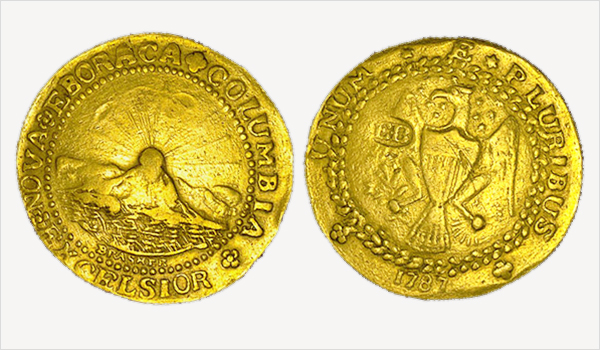
Weight – 406.8 grains
This doubloon was presumably removed by Adam Eckfeldt from the bullion deposits in the early 1800’s. It is at that time that the doubloon first achieved numismatic recognition. The specimen now lives in the National Numismatic Collection of the Smithsonian Institution.
2.) Yale University specimen
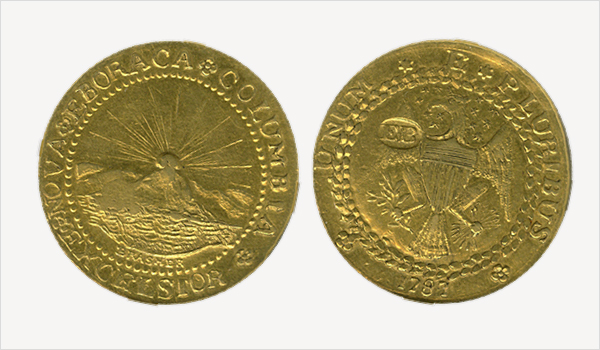
Weight – 407.5 grains
Diameter – 29.8 mm
Unknown thieves stole this coin from the Yale University collection but were recovered in 1967. By January of 1981, this specimen was offered by Yale University Stack’s for $650,000.
3.) Walter Perschke specimen
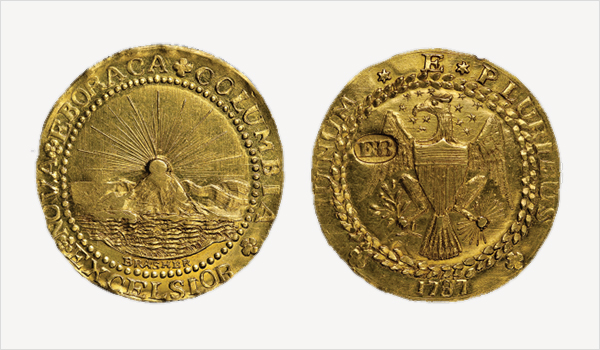
Weight – 407.4 grains
Famous numismatist Walter Perschke is the owner of this coin, which is believed to be the finest known example of the rare Brasher Doubloon. He purchased this Brasher Doubloon in 1979 for $430,000 USD, a record price for a coin back then. The Walter Perschke Brasher Doubloon is now valued at $10 million USD.
4.) The Garrett specimen
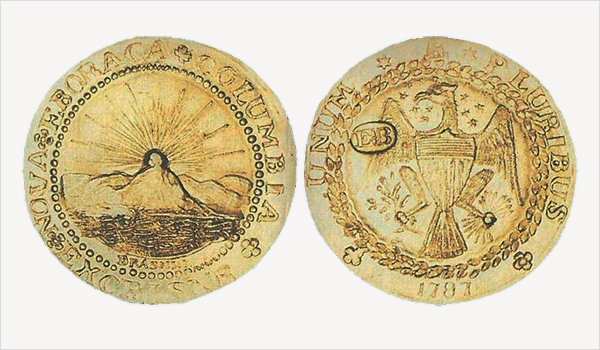
Condition – Not in circulation
Weight – 407.9 grains
This valuable Brasher Doubloon “Punch on Wing Type” was realized at $725,000 USD.
5.) American Numismatic Society Specimen
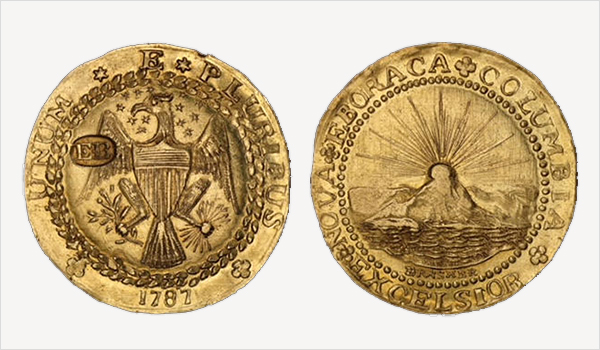
Weight – 411 grains
A very rare US gold coin owned by the American Numismatic Society includes a gold doubloon produced by Ephraim Brasher of New York in 1787. This was discovered in 1897 in a Philadelphia sewer and was donated to the American Numismatic Society in 1969.
6.) The Dupont specimen

Weight – 408.3 grains
In 1933, this specimen was sold by B. Max Mehl to Lammot duPont and Willis H. duPont. In October 1967 the coin was stolen from the duPonts at gunpoint but was retrieved in July of 1968.
7.) The Garrett specimen
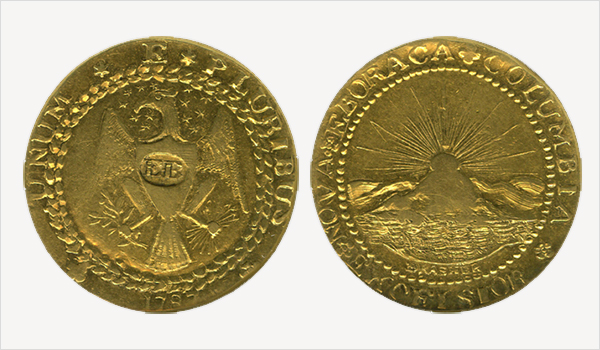
Mintage – Unrecorded
Diameter – 30 mm
Weight – 411.5 grains
This is the only existing example of the Basher doubloon with the EB hallmark on the shield of the eagle’s breast.
The 1787 Brasher “HALF DOUBLOON”
Due to the rarity of the Brasher half doubloons it had been considered priceless. The only existing example now lives in the Smithsonian’s Numismatic Collection and is being regarded to as the rarest of all American gold coins.
At first sight, the coin’s edges that bear the “Unum E Pluribus” and the New York text appear to have been cut off. It’s as though the coin had once been a regular doubloon but has been shaved for its gold.
Experts who have examined it believed that no shaving was performed on the coin. The planchet is thinner, the edge is normal and the weight, reported to be 204 grains, is approximately half that of the Brasher doubloon.
Brasher Dubloon replicas
In 1860, replicas of the Brasher doubloon started it’s production. They were intended to be collectible souvenirs and most are not worth much. However, some replicas, like the ones made in the 19th century have been minted in real gold worth thousands of dollars due to their own age and rarity.
Alfred Robinson of Hatford, Connecticut produced a copper proof copy imitation of Brasher’s gold doubloon in 1861. The lettering and date are in larger letters and in different styles than that of the original. Twenty-five of his imitations were struck in copper and another twenty-five were struck in brass.
Brasher doubloons value
The Bank of New York’s coinage standard on weight and value established in 1784 implies the doubloon’s weight at 17 pennyweights (about ¾ of an ounce) valued at $15.
The value of the Brasher doubloon gold coin was initially $16 but researchers later on showed it was erroneous and the doubloon was actually worth $15 at the time of its issue.
Ephraim Brasher’s prominence as an assayer, his skill and his integrity contributed much to the historic value of his doubloons. His inevitable extraordinaire dedication for his work was of great demand thus he was frequently called upon to perform assays on various gold coins which were current then in infant nations. As a mark of a guaranteed precise weight and fineness, his EB hallmark graced a diverse mix of European and Latin American issues.
Not only that, his close personal ties to George Washington, who happens to be his next door neighbor contributed to Brasher’s importance as a figure during the Confederation period.
In 2005, the rarest of the seven Doubloons, the “EB-on-breast”, was sold for $2.99 million. One of the six “EB-on-wing” doubloons was priced at $2.415 million. Another specimen held by the Yale University was auctioned in January 1998 with an $800,000 reserve but went unsold. Later, coins dealers, Donald Kagin and Jay Parrino jointly purchased it in February of that same year.
The Brasher Doubloon Collection
It was quite unclear how the Brasher dubloon collection being placed in the Mint’s collection ended up in the collection of Charles Bushnell in 1864. When Bushnell died in 1880, Lorin Parmelee bought the entire collection for $8, 000.
Parmelee removed some of the coins and she transferred the remaining collection, including the Punch-on-Breast Doubloon to Henry and SaWmuel Chapman of Philadelphia.
New York coin dealer, Edouard Frossard purchased the doubloons at an auction in 1882 for $505. Frossard was then representing T. Harrison Garrett of Baltimore, who was assembling one of the greatest coin collections of all time. It was later passed on to Garrett’s son Robert, after his sudden death in 1888.
In 1919, Robert traded the collection for artwork to his brother John who had the same penchant for coin collecting as his father. The collection was donated to Johns Hopkins University upon John’s widow Alice Garrett’s death in 1952. John died ten years before her.
Below is a timeline as to who owned the Punch-on-Breast Doubloon after the Garretts, when, and the price upon its purchase:
1981 – Auctioned by Bowers and Ruddy. An anonymous buyer from Florida bought the unique 1787 Brasher Doubloon for $625,000.
1994 – Well-respected California coin dealer Don Kagin purchased the coin through an agent and then sold half interest to Midwestern dealer Jay Parrino.
February 1998 – Parrino brokered the coin for his client and sold it to the owner of the Gold Rush Collection, one of the South’s premier private collections managed by Georgia dealer, Al C. Adams
January 12, 2005 – Gold Rush Collection, containing the unique Punch-on-Breast Doubloon was auctioned by Heritage Galleries. President of Rare Coin Wholesalers of Dana Point, California, Steven L. Contursi and Donald Kagin, President of Kagin’s of Tiburon, California, bought it for $2,990,000. It was the second highest price paid ever paid for a coin at that time.






Leave a Reply